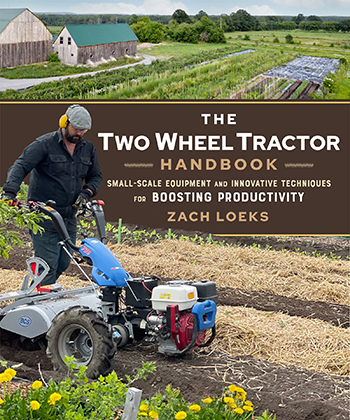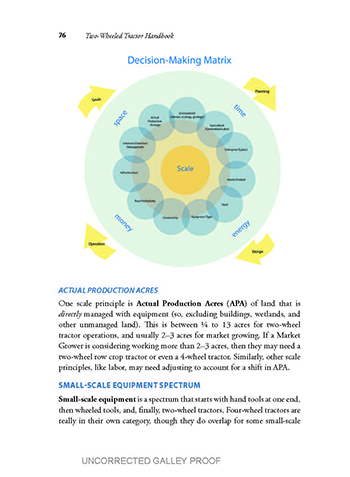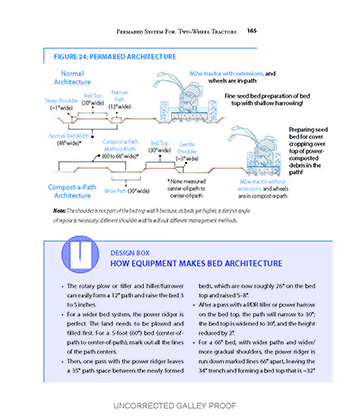Learning to farm vegetables for market requires balancing: you want to follow successful models and stick to a plan, but also be flexible as you respond to your unique conditions. There are wonderful books that share specific, well-defined systems of machinery, spacings, crops and their sequences, soil management, and marketing. Clear models from experienced farmers can be very helpful, but at the same time we want farmers to see the underlying principles behind each model – because seeing that bigger picture can give you more clarity to make deliberate decisions as you react to problems and grow your farm (each a unique organism). At any scale, the machinery a farmer chooses defines many things about the farm – like the amount of land that will be used and the amount of money needed for start-up. Wouldn’t a structured discussion of scale and machinery by a creative and experienced farmer be nice?
 The Two Wheel Tractor Handbook is available for preorder from Growing for Market for $39.99. Books will ship as soon as we get them from the publisher in April. Subscribers always get 20% off all books at growingformarket.com.
The Two Wheel Tractor Handbook is available for preorder from Growing for Market for $39.99. Books will ship as soon as we get them from the publisher in April. Subscribers always get 20% off all books at growingformarket.com.
In the last five years a great interest has grown in two-wheel tractors, and for good reason! They make farming more accessible by allowing people to start growing more intensively on less land, which means less investment in land and machinery, and reduces the physical strain of handwork. I want to thank and recognize Jason Weston, Jeff Lauber, Will Stauffer, and the Tilmor Company for all they’ve each done to share two-wheel tractor knowledge and tools with the world. Many popular published production systems feature two-wheel tractors, but there has not been a resource focusing on the tool and scale itself. I was excited when I learned about The Two Wheel Tractor Handbook by Zach Loeks, and was given the opportunity to review it for this fine magazine.
Mr. Loeks has a lot of experience to draw on from his work as a market grower, permaculturist, and farm kid. The book is divided into 8 chapters. I’ll briefly summarize some chapters and spend more time discussing what I found to be the most interesting, new, and unique parts of the book.
Chapters one, two, and three explain the history of walk behind tractors, tractor models and their parts, and implements. I think that these chapter will be helpful for someone with no or little experience with these machines. But those who have been watching YouTube videos, learning on Facebook groups, or reading other farming books may find these sections less interesting.
At times the tractor and implement sections read like BCS tractor manuals – but without all the technical information those include. At other points these chapters felt like I was reading directions on how to make a peanut-butter and jelly sandwich – reading the written directions to teach a topic that makes a lot more sense to learn hands-on in person or from a video. As the basic steps of tractor operation were described I found myself wanting to just read an actual BCS manual that included more details. I should note that this book is not a shop manual and should not take the place of a shop manual – if you own a walk behind tractor, the manufacturer’s manual for it as well as a repair manual for the small engine that powers it would be great companions to this book. This section also included some information that seemed a little too simple – like a picture of how to pour gas into the gas tank.

A diagram from page 76 in the book, which shows the many interconnections between scale principles. All images courtesy of New Society Publishers.
What I appreciated about these machine-focused sections were the hands-on, experienced-based tips scattered throughout. The book in general is very reader-friendly, with sidebars and pro-tips throughout all of the chapters that highlight certain subjects. Additionally, there were discussions explaining specific tractor options and implements that I don’t know of existing elsewhere. For example, I appreciated the discussion about the different types of clutches (wet and dry) and the strengths and weaknesses of each and the type of work each clutch is suited to. Zach’s experience is valuable, and I learned from his tips on tractor safety (I now know about anti-vibration work gloves). The implement section described tools for tillage, mowing, chipping, etc. Though helpful, similar information is found at the BCS website as well as videos.
 Diagram from page 82 of the book. The limit of two-wheel tractor suitability is not set in stone. There is no magical “acreage-ceiling.” That being said, one can get a general sense of the equipment, labor, and actual acreage needs for different enterprises.
Diagram from page 82 of the book. The limit of two-wheel tractor suitability is not set in stone. There is no magical “acreage-ceiling.” That being said, one can get a general sense of the equipment, labor, and actual acreage needs for different enterprises.
What I did appreciate is learning Zach’s opinion of each tool, its best use, and especially little tips that would save some headaches and poor performance – like now I know that the power harrow works best with a front bumper weight on the tractor for better balance. I’ve heard this type of experienced-based advice called “$100 ideas” – they can easily save you money and time by saving your having to figure them out the hard way. These $100 ideas are the types of things that differentiate the work of professional farmers from amateurs, and there is a seam of them throughout the book.
It was chapter four, five, and six that I found to be purely golden. Here lies Zach’s discussion of choosing a scale of farming, seeing implements as ‘guilds’ that should work to complete production cycles, and the detailed description of spacing for a cultural system. Allow me to elaborate please.
 Examples of equipment “guilds” from The Two Wheel Tractor Handbook.
Examples of equipment “guilds” from The Two Wheel Tractor Handbook.
As a new or seasoned farmer, all your decisions add up to choosing the scale at which you will produce and market – choosing a scale of production is foundational and affects all aspects of your farm. There are many perspectives to consider when choosing a scale that is right for you. This is complicated stuff (at least for me) that I rarely find discussed wholistically and focused on market-crops. There are many aspects that affect whether the scale of production suits the farmer - you could ask yourself: Do I like working with machines? How much land am I able to rent or buy now and in the future? How much infrastructure will I eventually build? Do I like managing people? Where will I market? And the answers to all these questions would inform which scale is right for you.
I am a visual learner and I love a good diagram to show me how ideas are related. The book is filled with creative and clear diagrams that communicate word-intense, complicated ideas into pictures. This was helpful to me and made the book more fun and engaging to read. For example, the diagram on this page shows the questions asked above about scale and their relationship.
As an explanation to this diagram, Zach writes: “The Holistic Principles of Scale shows interrelated principles for land management decision-making. Scale principles include labor, acreage, extensive/intensive management, and more. All should be understood relative to one another. Use these principles when planning by asking yourself: How does my consideration related to this principle affect the others? For instance, equipment type is an important principle—with great variation. For some growers, hand tools are sufficient, while other farmers require two-wheel or four-wheel tractors. How does this affect other principles of scale? Using scale principles for decision-making can help determine which equipment is enterprise- and scale-suitable and focuses wise investment over time as you scale-up using multi-functional equipment strategies to get more bang for your buck!” I appreciate this type of bigger picture thinking.

Diagram from page 165 in the book. Note the poetry: “...a distinct angle of repose is necessary...” - I didn’t know if this was a farming book or a romance novel!
Another diagram, reproduced above, shows Zach’s clear and holistic thinking. You can see how the diagram conveys the connection between production acres, number and type of walk behind tractors, enterprise type, and labor. To me such clear information is very helpful in planning or refining farm enterprises, scope, and equipment.
Further on, Zack urges us to identify our “intended static scale” – your ideal scale of production and marketing that you can live steadily from (and maybe raise a family with). This is the scale of farming where you don’t expand further and instead start to really refine the existing systems. Most farmers take several years, say 5-10, to get to their right mix of land, infrastructure, machinery, and marketing. He defines these stages of farm growth as 1. Startup – focusing on setting goals and essential production; 2. Scale-up – planning more projects and greater productivity; and 3. Pro-up – a refinement of operation cycles and solving of remaining weak links. Hopefully this progression leads to a static scale – where one can enjoy running a farm that has been consciously and solidly built. When we’ve chosen our intended static scale (for either part-time or full-time work), we can choose our equipment priorities so that implements more essential to the core tasks are purchased first, and then later as we have money from the sale of sweet, sweet vegetables, implements that make jobs easier or increase production can be bought. As one of the many fun ‘Pro Tip’ boxes says, “the more precisely you can define your static-scale goal, the better choices you can make for equipment as you start-up and scale-up.”
To understand the groups of machinery best suited to different times in a farm’s growth, Zach speaks about equipment guilds. “A guild is a companionship of three or more mutually beneficial entities. There are guild designs for plants, equipment and enterprises . . . Equipment guilds put the grower in the mindset of “which implements work well together” to complete whole operation cycles rather than focusing on specific tasks.” I love this bigger picture thinking. See the diagram on the facing page for some examples of equipment guilds.
I appreciated so much that the book discusses not what to do, but rather how your choices can be part of a bigger picture. And that was just in chapter four!
Chapter five identifies several example static scales and enterprises, and the equipment guilds that can grow with them; such as tree nursery, market garden, market farm, or landscaper. In chapter five and throughout the book are “Design Box” sections that take a deeper dive into topics like tillage, understanding cultivation, setting up a weeding tool, and the culture of transplants. I found these gave both an overview of the topic and helpful details.
Chapter six shared a specific system of production and culture Zach has developed - his Permabed system. It was so fun for me and got me excited about growing plants to see such a well-explained and planned system that I could imagine working well. Zach has written an earlier book focused on this permabed system, called The Permaculture Market Garden.
It included detailed information on spacings, a topic that I think is very helpful for farmers to consider carefully before buying equipment. I find that discussions of crop, bed, and wheel spacings are rarely discussed thoroughly in farming books. The diagram on the next page communicates so much about spacing considerations.
What follows this diagram is an entire discussion on where to set your wheels and the pros and cons; on top of the bed, on bed shoulders, or in pathways. The chapter went further in explaining further refinements in this permabed system - like how to group annual and perennial crops, pathway management, residue management, and equipment costs for different scales of the system.
The penultimate chapter discusses the specifics of starting a farm from scratch using two-wheel tractors, and the final chapter covers tractor maintenance and care. The maintenance tips gave a great overview of how to understand the different maintenance tasks and would be a good companion to the tractor and implement manuals, which give more specific details.
This book sells for about $40 ($31.99 for GFM subscribers). If you are using or planning to use two-wheel tractors in any part of your operation, this book provides a valuable bigger picture perspective on systems and scale, and lots of $100 ideas. Enjoy!
The Two Wheel Tractor Handbook is available for preorder from Growing for Market for $39.99. Books will ship as soon as we get them from the publisher in April. Subscribers always get 20% off all books at growingformarket.com.
Sam Oschwald Tilton is a horticulture instructor at Lakeshore Technical College, just north of Sheboygan, Wisconsin. He has a background in vegetable farming and earned a master’s degree in horticulture from Michigan State University, where he studied weeding tools and techniques. Sam was the Midwest Sales Representative for KULT-Kress precision cultivation tools. He enjoys jokes and popcorn.
